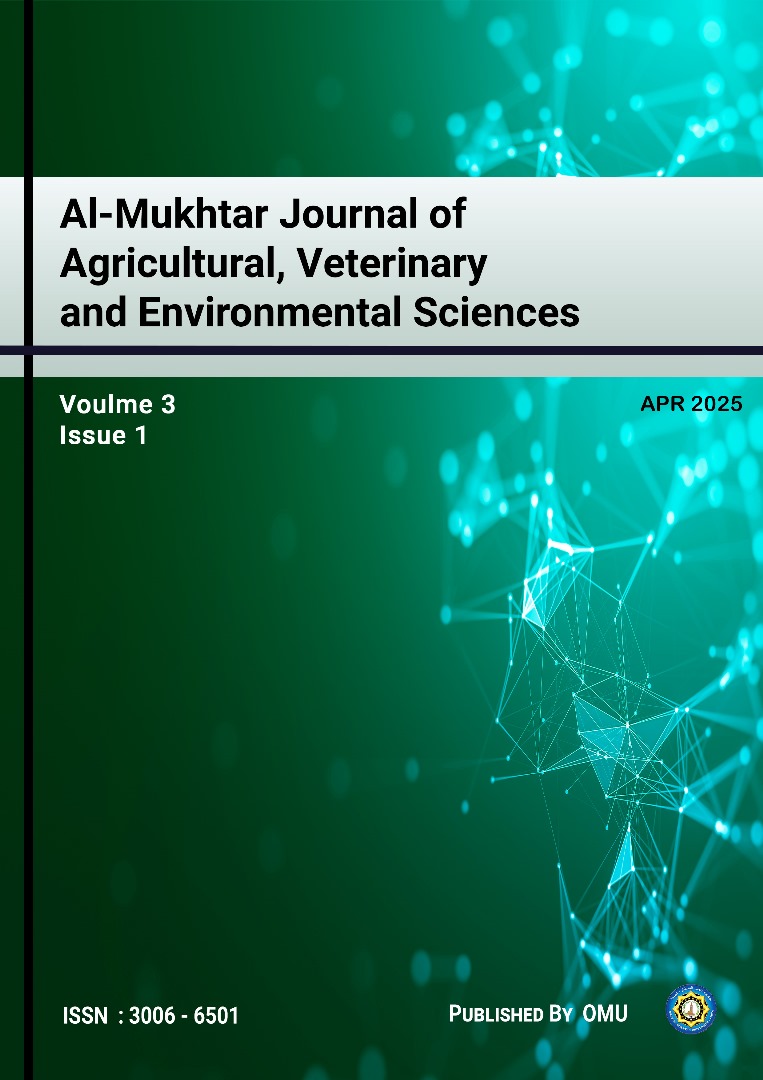Effect of Previous Crop Residues on The Growth and Development of Squash Plants
DOI:
https://doi.org/10.54172/8scd6863Keywords:
Allelopathic; Cucurbita pepo L.; Squash; Aqueous extract; Crop residues, Olive residuesAbstract
The seedlings of Squash (Cucurbita pepo L.) were irrigated with aqueous extract of crop residues of barley, wheat or oat, at a concentration of 50 g.L-1, or olives at 25, 50, 75 and 100 g.L-1, in addition to the control treatment (tap water) until the flowering stage. A completely randomized design was used with the treatments. The results showed that the fresh and dry weight of the shoots decreased by (27, 26, 33%) and (26, 35, 44%), and the number of leaves and flower buds (20, 20, 25%) and (28, 24, 40%) and leaf petiole length (38, 41, 47%), when treated with aqueous extract of the residues of each of barley, wheat, or oats, respectively, compared to the control. The results also showed the effect of the aqueous extract of olive residues on the growth measurements of squash plants, and the rate of decrease was directly proportional to the increase in the concentration of the aqueous extract, and thus both the fresh and dry weight of the shoots decreased by 51% and 42%, roots 43% and 25%, plant length 40%, number of leaves 29%, and leaf area 70%, respectively, compared to the control. The results obtained show that the aqueous extract of different plant residues have a clear role in reducing the growth of squash plants, and thus, this will be reflected in productivity later. This type of effect is clearly due to the presence of an "allelopathic" effect from growth-inhibiting substances present in the tissues of previous plant residues or their presence simultaneously with squash plants in the field.
References
Abu-Romman, S. (2016). Differential allelopathic expression of different plant parts of Achillea biebersteinii. Acta Biologica Hungarica, 67(2): 159-168.
Alasheebi, S. A., Al Gehani, I. A., & Mohammed, T. M. (2021). Effect of Aqueous Extract of some Windbreak Tree Leaves on Seed Germina-tion and Seedling Growth of Squash. Al-Mukhtar Journal of Sciences, 36(3): 223-230.
Al-Samarai, G. F., Mahdi, W. M., & Al-Hilali, B. M. (2018). Reducing environmental pollution by chemical herbicides using natural plant derivatives–allelopathy effect. Ann. Agric. Environ. Med., 25(3): 449-452.
Ashrafi, Z. Y., Sadeghi, S., &Mashhadi, H. R. (2007). Allelopathic effects of barley (Hordeumvulgare) on germination and growth of wild barley. Pak J Weed Sci Res., 13(1-2): 99-112.
Ben-Hammouda, M., Ghorbal, H., Kremer, R., &Oueslati, O. (2001). Allelopathic effects of barley extracts on germination and seedlings growth of bread and durum wheats. Agronomie, 21(1): 65-71.
El-Shora, H. M., & El-Gawad, A. M. A. (2015). Physiological and biochemical responses of Cucurbitapepo L. mediated by Portulacaoleracea L. allelopathy. Fresenius Environmental Bulletin, 24(1b): 386-393.
Endeshaw, S. T., Lodolini, E. M., &Neri, D. (2015). Effects of olive shoot residues on shoot and root growth of potted olive plantlets. ScientiaHorticulturae, 182: 31-40.
Kluthe, B., Ali, M., & Stephenson, S. (2018). Allelopathic influence of Eucalyptus on common Kenyan agricultural crops. J AgronAgric Sci., 1(1): 2-6.
Kumari, N., Srivastava, P., Mehta, S., & Das, B. (2016). Allelopathic effects of some promising agro forestry tree species on different annual crops. Eco. Env. & Cons., 22(1): 225-236.
Mahmood, K., Khaliq, A., Cheema, Z. A., &Arshad, M. (2013). Allelopathic activity of Pakistani wheat genotypes against wild oat (Avenafatua L.). Pak. J. Agri. Sci., 50(2): 169-176.
Orr, S. P., Rudgers, J. A., & Clay, K. (2005). Invasive plants can inhibit native tree seedlings: testing potential allelopathic mechanisms. Plant Ecology, 181, 153-165.
Popolizio, S., Fracchiolla, M., Leoni, B., Cazzato, E., & Camposeo, S. (2022). Phytotoxic Effects of Retentates Extracted from Olive Mill Wastewater Suggest a Path for Bioherbicide Development. Agronomy, 12(6): 1378.
Saleh, A. M. (2013). In vitro assessment of allelopathic potential of olive processing waste on maize (Zea mays L.). Egypt. J. Exp. Biol, 9(1): 35-39.
Shao, Q., Li, W., Yan, S., Zhang, C. O. N. G. Y. U., Huang, S., &Ren, L. (2019). Allelopathic effects of different weed extracts on seed germination and seedling growth of wheat. Pakistan journal of botany, 51(6): 2159-2167.
Sikolia, S. F., & Ayuma, E. (2018). Allelopathic effects of Eucalyptus saligna on germination growth and development of Vigna Unguiculata L. Walp. IOSR Journals, 12(3): 15-24.
Tanveer, A., Rehman, A., Javaid, M. M., Abbas, R. N., Sibtain, M., Ahmad, A. U. H., Ibin-I-Zamir, M. S., Chaudhary, K., & Aziz, A. (2010). Allelopathic potential of Euphorbia helioscopia L. against wheat (Triticum aestivum L.), chickpea (Cicera rietinum L.) and lentil (Lens culinaris Medic.). Turkish Journal of Agriculture and Forestry, 34(1): 75-81.
Tubeileh, A. M., & Souikane, R. T. (2020). Effect of olive vegetation water and compost extracts on seed germination of four weed species. Current plant biology, 22: 100-150.
Vijayan, V. (2015). Evaluation for allelopathic impact of Acacia auriculiformis A. Cunn. ex Benth on Seed germination and Seedling growth of Rice (Oryza sativa L), a widely cultivated Indian crop species. Research Journal of Agriculture and Forestry Sciences -ISSN, 2320, 6063.
Wang, Y., Wu, F., & Zhou, X. (2010). Allelopathic effects of wheat, soybean and oat residues on cucumber and Fusarium oxysporum f. spcucumerinum Owen. Allelopathy Journal, 25(1): 107-114.
Watson, D. J. (1937). The estimation of leaf area in field crops. J. Agric. Sci., 27:474-483.
Zaïri, A., Nouir, S., Zarrouk, A., Haddad, H., Khelifa, A., &Achour, L. (2020). Phytochemical profile, cytotoxic, antioxidant, and allelopathic potentials of aqueous leaf extracts of Olea europaea. Food Science & Nutrition, 8(9): 4805-4813.
Zuo, S. P., Ma, Y., Deng, X. P., & Li, X. W. (2005). Allelopathy in wheat genotypes during the germination and seedling stages. Allelopathy Journal, 15(1): 21-30.
Downloads
Published
Issue
Section
License
Copyright (c) 2025 sami alasheebi (Author)

This work is licensed under a Creative Commons Attribution-NonCommercial 4.0 International License.













